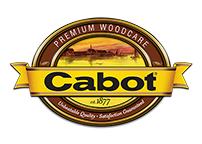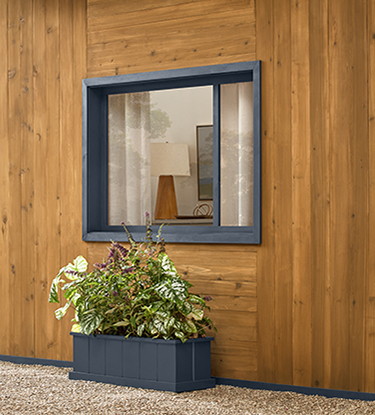
- Assess Wood
- Prep
- Application
ASSESSING THE CURRENT STATUS OF YOUR WOOD
The first place to start with any exterior wood project is to understand what you are working with. Exterior wood, no matter if it’s decking or siding, can have a variety of challenges that need to be addressed before staining.
It’s important to understand the condition of your wood surface before you strip as not all decks need to have the previous coating removed. For example, if you are going to lighten your wood and go from a solid to a semi-transparent finish, or make a dramatic color change, then stripping is required. The same is true if the surface of the wood has experienced extreme weathering and cracking and blistering of the previous coating has occurred.
MOLD AND MILDEW
This is one of the most common occurrences on exterior wood surfaces and is usually mistaken for dirt. This can show up as small black spots or greenish/black fuzzy spots. Left untreated mold and mildew will start to rot the wood surface.
PEELING
You will notice previous coats of stain or paint that are failing on the surface will begin to peel and pull away from the wood substrate. Unsound surfaces such as these must be removed or sanded down to a sound surface. A tape test can help determine if the coating is tightly sticking to the wood.
TANNIN BLEED
This reddish-brown discoloration is caused by moisture drawing tannins to the surface. Though it won’t harm an existing coating, it is visually unpleasant and it could affect adhesion of a stain in high enough concentrations.
WEATHERED WOOD
Wood will begin to show signs of weathering after sitting uncovered or if a previous coat fails. Weathering usually presents itself as a grey or silver appearance on the surface. Other signs include wood that flakes or appears very soft when pressed with a fingernail. Weathered wood must be removed from the surface prior to staining or painting.
NEW WOOD
Beware, new wood may need preparation too. Mill glaze on fresh cedar or newly treated lumber has a tendency to repel stains. Mill glaze is a result of sawing of the wood and actually closes the grains to prevent penetration of the stain. This can be resolved by sanding the wood lightly. On the other hand, freshly treated lumber will not allow a stain to adhere until the treatment has worn down and the lumber dries out. The presence of either of these issues can be determined by a simple water test. Wet the surface with a garden hose and see if the water beads up. If so, you will need to lightly sand. In the case of treated lumber, we recommend that you test the surface every few months for penetration, once the water penetrates you can stain the surface.
The most important step in a successful staining project is prep. But, what exactly does that entail? It’s important to assess the situation in which you’re working. Before getting started, here are a few key factors to consider when planning and preparing. Remember, the key is to know what you’re dealing with. Be sure to get up close and pay attention to the small details.
Preparation Steps
CLEANING
It is crucial that you remove any mold, mildew and dirt from the surface of the wood.
A good cleaner formulated specifically for wood and will remove mold & mildew. Cleaning the deck with a stiff bristle deck brush is a necessary step in any successful staining project. This will remove mildew stains and provide a sound surface to stain. You never want to use regular soap and water to prep a surface because soap will leave behind residue which will reduce penetration. When thinking about other household cleaners, note that they either won’t effectively clean the surface and/or could damage the wood.
Follow the product guidelines for the cleaning solution carefully.
SANDING
If the surface still has loose wood fibers, splinters, or has a very rough feel to it, we recommend that it be sanded smooth with a 80-100 grit sand paper. This is strong enough to smooth the surface and still allow stain to penetrate. (TIP: Always sand in the same direction as the wood grain to avoid marking the surface with your sandpaper).
There are numerous electric sanders on the market to assist you with this task. If there is a small section of decking that needs attention, a pole sander will helps with the task and is easier on the back than bending down.
GRINDING
Mechanical grinding can damage or destroy a wood surface very easily and should be left to a professional.
A Note About Priming
When you plan to apply a solid color stain to a deck or if you have your siding has chronic problems like continued Tannin Bleed, we recommend the use of a primer first. A primer will increase the adhesion of the topcoat therefore extending the life of the stain. Oil-based primers help with moisture vapor transfer on siding. In many cases, moisture trapped behind an unprimed coating can lead to surface peeling.
Application Tools
- Sprayer
- Brush – 4” block
- Pad
- Nap Roller
Techniques
Using a brush or paint pad will give you the most control. Brush application (natural bristle) is the preferred method because it works the oil-based stain into the wood fibers and cells more effectively. To avoid lap marks, make sure that the leading edge is kept wet and that the wet stain is brushed into the wood. On new decks, it is important to only apply one coat of oil-based deck finishes.
- First, heavily coat the open end grain of the boards.
- When brushing out a stain, it is good practice start at far end of the project and stain outward.
- Stain 1-2 boards at a time working the entire length while keeping a wed edge. This will help minimize lap marks.
- Finish with a heavy coat at the open-end grain on the opposite side of where you started, ending as you began.
Tip: During new construction, staining should be a 6-sided process, don’t forget to stain the sides and front and back edges of the board.
A contracting team may apply using a roller or sprayer, but this should always be followed by back brushing. This technique should only be used by professionals with the ability to work quickly.
Are More Coats Better?
A major source of problems for deck finishes is the over-application of the coating. Many homeowners and even some professional paint contractors incorrectly believe “more is better.” In order for an oil-based stain to be effective, it must be able to penetrate the wood’s surface. Over-application leads to a buildup of material, forming a film on the wood which can ultimately peel or crack when exposed to excessive moisture. Too much oil-based product can also produce an excessively waxy, sticky or slick surface, interfering with the finish’s ability to dry properly.
Color Coverage
There are important objective factors that influence color perception. Among these are the coatings themselves, the wood or substrate texture, subcoats and light source. The color of the wood or substrate will affect the appearance of all stain products; and this is especially true of clears, translucent, semi-transparent and semi-solid stains. Porous wood, such as rough-cut lumber, will absorb more product and allow more of the substrate to show through.
A color will appear different under various light sources as the pigments in a coating absorb or reflect different wavelengths of light. Observe the color under the proper light source; i.e., exterior stains should be viewed under daylight conditions.
Color samples such as color cards and stained or painted wood chips offer an approximation of the true color. Never rely solely on a small chip to determine a final color choice. A color chosen from a one-by-one-inch sample will look a lot darker when applied to a large surface. In addition, take into consideration that store-matched colors may not match exactly to a manufactured ready-mix color.
For best results, a sample of the chosen color should be brushed out on the surface to which it will be applied. Colors change as they dry; therefore, no color decision should be made until the product is completely dry. This is especially true of latex or water-based products.
Just like all home improvement projects you want to be mindful of the safety instructions on the products and tools. Always apply common sense liberally, wear clothes you don’t mind ruining and protect your skin and eyes.
Tips:
- Cover the area below your deck while staining to protect landscaping
- Stain in the early morning or late afternoon to give your deck time to dry
- Always use the same brand cleaner and stain to ensure compatibility
